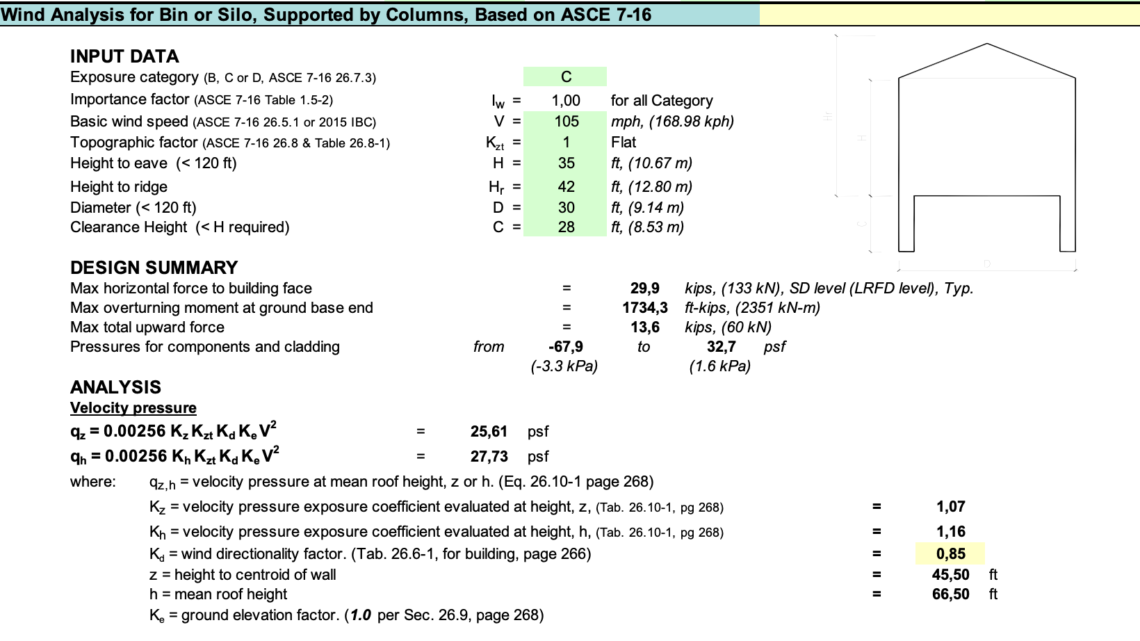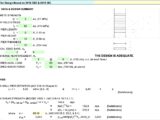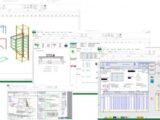
Wind Analysis for Bin or Silo Based on ASCE 7-16 Spreadsheet
2 January 2025Table of Contents
Wind Analysis for Bin or Silo Based on ASCE 7-16 Spreadsheet
When designing bins or silos, ensuring structural integrity under wind loads is crucial. The American Society of Civil Engineers (ASCE) provides guidelines in ASCE 7-16 for calculating wind loads on structures, including bins and silos. Using a spreadsheet to perform these calculations can streamline the process and improve accuracy. This article will guide you through the key aspects of wind analysis for bins or silos based on ASCE 7-16 and how to use a spreadsheet for efficient calculations.
Why Wind Analysis is Important for Bins and Silos
Bins and silos are often tall, cylindrical structures that are highly susceptible to wind forces. Without proper wind analysis, these structures can experience:
- Structural failure due to excessive wind pressure.
- Overturning or tilting caused by wind-induced moments.
- Damage to stored materials if the structure is compromised.
Wind analysis ensures that bins and silos are designed to withstand local wind conditions, ensuring safety and longevity.
Key Steps in Wind Analysis Based on ASCE 7-16
- Determine Basic Wind Speed:
- ASCE 7-16 provides wind speed maps for different regions. Identify the basic wind speed for your location.
- Calculate Wind Pressure:
- Use the formula provided in ASCE 7-16 to calculate wind pressure. Factors include:
- Wind directionality factor (Kd).
- Exposure category (B, C, or D).
- Topographic factor (Kzt).
- Gust effect factor (G).
- Use the formula provided in ASCE 7-16 to calculate wind pressure. Factors include:
- Determine Force Coefficients:
- For cylindrical structures like bins and silos, ASCE 7-16 provides force coefficients (Cf) based on the structure’s shape and surface roughness.
- Calculate Wind Load:
- Multiply the wind pressure by the projected area of the structure and the force coefficient to determine the wind load.
- Check for Overturning and Sliding:
- Ensure the structure can resist overturning and sliding moments caused by wind forces.
Using a Spreadsheet for Wind Analysis
A spreadsheet can simplify wind analysis by automating calculations. Here’s how to set up an ASCE 7-16-based spreadsheet:
- Input Section:
- Include fields for basic wind speed, structure dimensions, exposure category, and other factors.
- Calculation Section:
- Use formulas to compute wind pressure, force coefficients, and wind loads based on ASCE 7-16 guidelines.
- Output Section:
- Display the final wind load, overturning moment, and sliding force.
- Visualization:
- Add charts or graphs to visualize wind pressure distribution and structural response.
Benefits of Using a Spreadsheet
- Accuracy: Reduces manual calculation errors.
- Efficiency: Saves time by automating repetitive calculations.
- Flexibility: Allows easy adjustments to input parameters for different scenarios.
- Documentation: Provides a clear record of calculations for compliance and review.
Tips for Effective Wind Analysis
- Use Updated Codes: Always refer to the latest version of ASCE 7 for accurate calculations.
- Consider Local Conditions: Account for local topography and wind patterns.
- Validate Results: Cross-check spreadsheet results with manual calculations or software tools.
- Consult Experts: Work with structural engineers to ensure compliance with design standards.
Conclusion
Wind analysis is a critical step in designing bins and silos to ensure they can withstand wind forces. By following ASCE 7-16 guidelines and using a spreadsheet, you can streamline the calculation process and improve accuracy. Whether you’re an engineer, designer, or project manager, mastering wind analysis will help you create safer and more reliable structures.
For a ready-to-use ASCE 7-16 wind analysis spreadsheet, explore our downloadable template designed specifically for bins and silos. Simplify your wind load calculations and ensure your structures are built to last!


